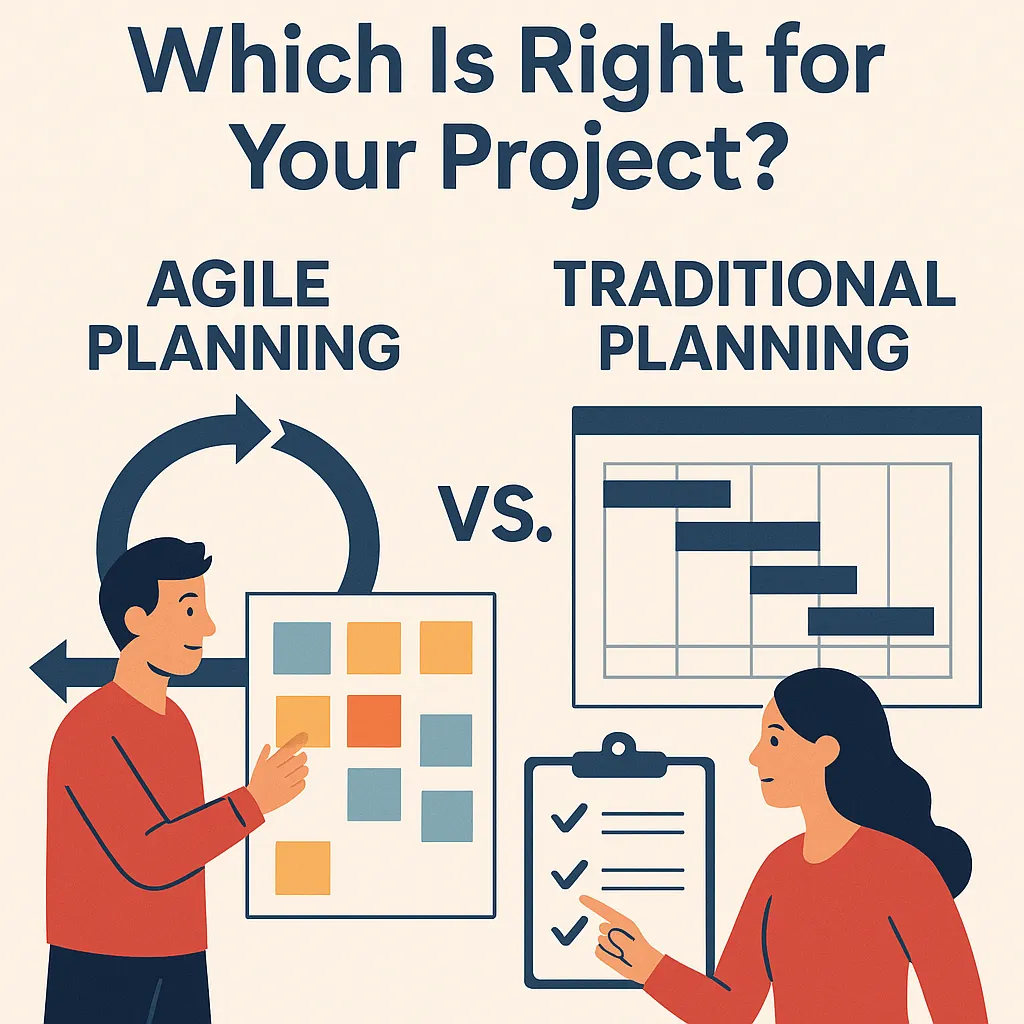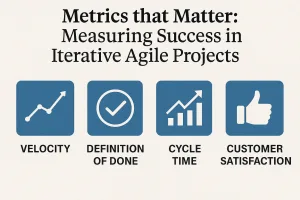Introduction to Project Planning Methodologies
Project planning is a critical component of project management that involves defining project goals, establishing timelines, allocating resources, and determining the necessary steps to achieve desired outcomes. Effective project planning not only sets the foundation for successful project execution but also helps in managing risks, ensuring stakeholder alignment, and optimizing resource utilization. In an ever-evolving business landscape, understanding different project planning methodologies is essential for project managers who aim to enhance their team’s efficiency and adaptability.
Agile Planning Methodology
Agile planning is a flexible and iterative approach that emphasizes collaboration, customer feedback, and rapid delivery of functional components. Unlike traditional methodologies, which often follow a linear path, agile planning allows teams to adapt to changes and continuously improve their processes. Key characteristics of agile planning include:
- Iterative Development: Projects are broken down into smaller, manageable units called iterations or sprints, allowing teams to deliver incremental value.
- Customer Collaboration: Agile methodologies prioritize customer involvement throughout the project lifecycle, ensuring that the final product aligns with user needs and expectations.
- Emphasis on Adaptability: Agile planning encourages teams to respond to changes quickly, whether they arise from market shifts or evolving project requirements.
Traditional Planning Methodology
In contrast, traditional planning methodologies, often referred to as Waterfall, follow a sequential and structured approach. This methodology is characterized by distinct phases, including initiation, planning, execution, monitoring, and closure. Key features of traditional planning include:
- Linear Progression: Each phase must be completed before moving on to the next, which can lead to longer project timelines.
- Comprehensive Documentation: Traditional planning relies heavily on detailed documentation and upfront planning, which can be beneficial for projects with well-defined requirements.
- Limited Flexibility: Once a project plan is established, making changes can be challenging and may require significant rework.
What is Traditional Planning?
Traditional project planning, often referred to as the Waterfall model, is a structured approach to project management that emphasizes a linear and sequential process. This methodology is characterized by its clear stages and defined deliverables, making it a popular choice for many project managers, especially in industries where requirements are well understood from the outset.
Characteristics of Traditional Planning
Linear and Sequential Process: Traditional planning follows a step-by-step approach where each phase must be completed before the next one begins. This structure helps in maintaining order and clarity throughout the project lifecycle.
Defined Stages: The traditional planning process is typically divided into five key stages:
- Initiation: This phase involves defining the project at a high level, including its purpose, scope, and stakeholders.
- Planning: Detailed planning occurs here, where project objectives, timelines, resources, and budgets are established.
- Execution: In this stage, the project plan is put into action, and the team works on delivering the project outputs.
- Monitoring and Controlling: Throughout execution, project managers monitor progress against the plan, making adjustments as necessary to stay on track.
- Closure: Finally, the project is formally closed, and deliverables are handed over, with a review of what was successful and what could be improved.
Common Methodologies
The most recognized methodology within traditional planning is the Waterfall model. This approach is particularly effective for projects with well-defined requirements and minimal expected changes. Other methodologies that fall under traditional planning include:
- PRINCE2 (Projects IN Controlled Environments): A process-driven project management method that emphasizes organization and control.
- PMBOK (Project Management Body of Knowledge): A set of standard terminology and guidelines for project management, providing a comprehensive framework for managing projects.
Benefits of Traditional Planning
- Clear Timelines: One of the primary advantages of traditional planning is the establishment of clear timelines. Each phase has specific deadlines, which helps in managing expectations and ensuring accountability among team members.
- Defined Deliverables: Traditional planning emphasizes the importance of deliverables at each stage, which aids in maintaining focus on project goals and outcomes. This clarity helps stakeholders understand what to expect and when.
- Predictability: The structured nature of traditional planning allows for better predictability in terms of project outcomes, making it easier to manage risks and allocate resources effectively.
What is Agile Planning?
Agile planning is a dynamic approach to project management that emphasizes flexibility, collaboration, and customer feedback. Unlike traditional planning methodologies, which often rely on rigid structures and extensive upfront planning, agile planning allows teams to adapt to changes and continuously improve throughout the project lifecycle. Here are the key characteristics and principles of agile planning:
Definition and Characteristics
- Iterative Process: Agile planning is characterized by its iterative nature, where projects are broken down into smaller, manageable units called iterations or sprints. This allows teams to deliver incremental value and make adjustments based on feedback at regular intervals.
- Flexibility: Agile planning embraces change, enabling teams to respond quickly to evolving requirements or market conditions. This adaptability is crucial in today’s fast-paced business environment, where customer needs can shift rapidly.
- Collaboration: Agile methodologies prioritize teamwork and communication. Cross-functional teams work closely together, fostering a collaborative environment that encourages input from all members, including stakeholders and customers.
Common Frameworks
Several frameworks embody the principles of agile planning, each with its unique practices and focus areas:
- Scrum: This framework organizes work into time-boxed iterations called sprints, typically lasting two to four weeks. Scrum emphasizes roles such as the Scrum Master and Product Owner, and includes ceremonies like daily stand-ups and sprint reviews to facilitate communication and accountability.
- Kanban: Kanban focuses on visualizing work in progress and managing flow. It uses a board to represent tasks, allowing teams to see the status of work items at a glance. This framework promotes continuous delivery and helps teams identify bottlenecks in their processes.
Iterative and Flexible Approach
Agile planning’s iterative approach allows teams to refine their work based on real-time feedback. This flexibility is essential for:
- Customer Feedback: Regular interactions with customers ensure that the product aligns with their needs and expectations. Feedback is integrated into the planning process, allowing for adjustments that enhance user satisfaction.
- Continuous Improvement: Agile teams regularly reflect on their processes and outcomes, identifying areas for improvement. This commitment to learning and adaptation fosters a culture of innovation and efficiency.
Benefits of Agile Planning
The advantages of adopting agile planning methodologies are significant:
- Adaptability: Agile planning enables teams to pivot quickly in response to changes, reducing the risk of project failure due to unforeseen circumstances.
- Enhanced Collaboration: By fostering a collaborative environment, agile planning encourages diverse perspectives and ideas, leading to more innovative solutions.
- Increased Customer Satisfaction: The focus on customer feedback ensures that the final product meets user needs, resulting in higher satisfaction and loyalty.
- Continuous Improvement: Agile methodologies promote a mindset of ongoing enhancement, allowing teams to refine their processes and deliver better results over time.
Comparative Analysis: Agile vs. Traditional Planning
The choice between agile and traditional planning methodologies can significantly impact project outcomes. Understanding the fundamental differences between these two approaches is crucial for project managers contemplating a shift in methodology. Below is a comparative analysis that highlights key aspects of agile and traditional planning.
Fundamental Philosophies and Approaches
- Agile Planning: Agile methodologies prioritize flexibility, collaboration, and customer satisfaction. The core philosophy revolves around iterative development, where projects are broken down into smaller, manageable units called sprints. This allows teams to adapt to changes quickly and deliver incremental value throughout the project lifecycle. Agile emphasizes continuous improvement and responsiveness to stakeholder feedback, fostering a culture of collaboration and innovation.
- Traditional Planning: In contrast, traditional planning, often referred to as the Waterfall model, follows a linear and sequential approach. This methodology is characterized by detailed upfront planning, where project phases are clearly defined and executed in order. Traditional planning relies heavily on documentation and adherence to a predetermined schedule, making it less adaptable to changes once the project is underway. The focus is on delivering a complete product at the end of the project timeline.
Flexibility and Adaptability vs. Structure and Predictability
- Agile Flexibility: Agile planning is inherently flexible, allowing teams to pivot based on changing requirements or market conditions. This adaptability is crucial in dynamic environments where customer needs may evolve. Agile teams regularly reassess priorities and can incorporate feedback from stakeholders at various stages, ensuring that the final product aligns closely with user expectations.
- Traditional Structure: Traditional planning offers a structured approach that can be beneficial for projects with well-defined requirements and low uncertainty. The predictability of this methodology allows for thorough risk assessment and resource allocation at the outset. However, this rigidity can become a disadvantage in fast-paced industries where adaptability is essential for success.
Stakeholder Engagement and Feedback Mechanisms
- Agile Engagement: Agile methodologies promote active stakeholder engagement throughout the project. Regular meetings, such as daily stand-ups and sprint reviews, facilitate ongoing communication and feedback. This continuous interaction helps ensure that the project remains aligned with stakeholder expectations and allows for quick adjustments based on their input.
- Traditional Engagement: In traditional planning, stakeholder engagement typically occurs at the beginning and end of the project. Initial requirements gathering is followed by a lengthy development phase, with limited opportunities for feedback until the project is completed. This can lead to misalignment between stakeholder expectations and the final deliverable, as changes made late in the process can be costly and time-consuming.
Handling Changes and Risks
- Agile Change Management: Agile planning embraces change as a natural part of the project lifecycle. The iterative nature of agile allows teams to respond to new information or shifting priorities without derailing the entire project. Risk management is integrated into each sprint, enabling teams to identify and address potential issues proactively.
- Traditional Risk Management: Traditional planning approaches changes and risks with a more cautious mindset. Changes are often seen as disruptions that can impact timelines and budgets. Risk management is typically conducted during the planning phase, with strategies developed to mitigate identified risks. However, this can lead to a lack of responsiveness if unforeseen challenges arise during execution.
When to Use Traditional Planning
Choosing the right planning methodology is crucial for the success of any project. While agile planning has gained popularity for its flexibility and adaptability, there are specific scenarios where traditional planning methodologies may be more suitable. Here are key points to consider when determining if traditional planning is the right choice for your project:
- Project Types Requiring a Structured Approach: Certain industries and project types, such as construction and manufacturing, inherently benefit from a structured planning approach. These projects often involve complex processes, regulatory requirements, and significant resource allocation, making a detailed upfront plan essential for ensuring compliance and safety. Traditional planning provides a clear roadmap, which is vital in environments where deviations can lead to costly delays or safety hazards.
- Well-Defined Requirements and Low Uncertainty: Traditional planning is particularly effective in situations where project requirements are well-defined and unlikely to change. For example, projects with fixed specifications, such as building a bridge or manufacturing a product with established designs, can leverage traditional methodologies to create comprehensive plans that outline timelines, budgets, and resource allocations. In these cases, the predictability of the project allows for a more linear approach, minimizing the need for iterative adjustments.
- Stakeholder Preferences for Detailed Upfront Planning: In many cases, stakeholders may prefer a traditional planning approach due to its emphasis on detailed documentation and upfront planning. This preference is often rooted in the desire for clarity and accountability. Stakeholders in sectors like government contracting or large-scale infrastructure projects may require extensive documentation and a clear project timeline before approving funding or resources. Traditional planning meets these expectations by providing a thorough project plan that outlines every phase, deliverable, and milestone.
When to Use Agile Planning
Agile planning is a dynamic approach to project management that emphasizes flexibility, collaboration, and customer feedback. It is particularly beneficial in scenarios where traditional planning methods may fall short. Here are some key points to consider when determining if agile planning is the right choice for your project:
- Project Types That Benefit from Flexibility: Agile planning is especially advantageous in environments such as software development and startups. These projects often require rapid adjustments due to changing market demands or technological advancements. The iterative nature of agile allows teams to adapt their strategies and deliverables quickly, ensuring that the final product aligns closely with user needs and expectations.
- Evolving Requirements and High Uncertainty: Projects characterized by evolving requirements and high levels of uncertainty are prime candidates for agile methodologies. In industries where customer preferences can shift rapidly, such as technology or consumer goods, agile planning enables teams to pivot and refine their approach based on real-time feedback. This adaptability helps mitigate risks associated with unforeseen changes and enhances the likelihood of project success.
- Importance of Quick Iterations and Responsiveness to Feedback: Agile planning promotes a cycle of quick iterations, allowing teams to release functional components of a project incrementally. This approach not only facilitates early detection of issues but also encourages continuous improvement based on stakeholder feedback. By prioritizing responsiveness, agile teams can make informed decisions that enhance product quality and customer satisfaction, ultimately leading to better project outcomes.
Hybrid Approaches: Combining Agile and Traditional Planning
The debate between agile and traditional planning methodologies has been ongoing. However, many organizations are discovering the benefits of a hybrid approach that integrates elements from both methodologies. This section explores the concept of hybrid project management, its principles, and how organizations can effectively leverage the strengths of both agile and traditional planning to enhance project outcomes.
Defining Hybrid Project Management
Hybrid project management refers to the combination of agile and traditional (often referred to as waterfall) methodologies to create a tailored approach that meets the specific needs of a project. This methodology recognizes that no single approach is universally applicable and that different projects may require different strategies. Key principles of hybrid project management include:
- Flexibility: The ability to adapt processes and practices based on project requirements and stakeholder feedback.
- Iterative Development: Incorporating agile practices such as iterative cycles and continuous feedback while maintaining structured phases typical of traditional planning.
- Stakeholder Engagement: Ensuring that all stakeholders are involved throughout the project lifecycle, which is a hallmark of agile methodologies.
Leveraging Strengths of Both Methodologies
Organizations can harness the strengths of both agile and traditional planning by adopting a hybrid approach in several ways:
- Risk Management: Traditional planning provides a comprehensive risk management framework, while agile allows for quick adjustments in response to unforeseen challenges. By combining these approaches, project managers can create robust risk mitigation strategies that are both proactive and reactive.
- Resource Allocation: Traditional methodologies often excel in resource allocation and scheduling, providing a clear roadmap for project execution. Agile methodologies, on the other hand, promote flexibility in resource management. A hybrid approach allows project managers to allocate resources effectively while remaining adaptable to changes in project scope or requirements.
- Enhanced Communication: Agile emphasizes regular communication and collaboration among team members, which can be integrated into traditional planning frameworks. This ensures that all team members are aligned and informed, reducing the likelihood of miscommunication and project delays.
Examples of Successful Hybrid Implementations
Several organizations have successfully implemented hybrid project management approaches, demonstrating the effectiveness of combining agile and traditional methodologies:
- IBM: IBM has adopted a hybrid approach in its software development projects, blending agile practices with traditional project management techniques. This integration has allowed them to respond quickly to market changes while maintaining a structured development process.
- CERN: The European Organization for Nuclear Research (CERN) utilized a hybrid model for its Large Hadron Collider project. By combining agile sprints for software development with traditional planning for hardware construction, CERN was able to manage complex interdependencies effectively and deliver results on time.
- NASA: NASA has implemented hybrid project management in various missions, such as the Mars Rover projects. By integrating agile methodologies for software development with traditional planning for hardware and logistics, NASA has improved collaboration and adaptability in its projects.
Conclusion: Choosing the Right Methodology for Your Project
Selecting the appropriate planning methodology is crucial for achieving project success. Both agile and traditional planning approaches offer distinct advantages and challenges, making it essential for project managers to align their chosen methodology with specific project goals, team dynamics, and stakeholder preferences. Here are the key takeaways to consider when making this decision:
- Alignment with Project Goals: The first step in choosing a methodology is to ensure it aligns with the overarching goals of the project. Agile methodologies, with their iterative and flexible nature, are particularly suited for projects that require rapid adaptation to change and continuous stakeholder feedback. In contrast, traditional planning methods may be more effective for projects with well-defined scopes and stable requirements, where a linear approach can facilitate thorough planning and execution.
- Understanding Team Dynamics: The composition and working style of your team play a significant role in determining the best planning methodology. Agile teams thrive in collaborative environments where communication and adaptability are prioritized. If your team is accustomed to structured processes and prefers clear guidelines, a traditional approach may be more suitable. Assessing your team’s strengths and preferences can help in selecting a methodology that enhances productivity and morale.
- Stakeholder Preferences: Engaging stakeholders early and often is vital in project management. Agile methodologies encourage regular interaction and feedback, which can lead to higher stakeholder satisfaction. Conversely, traditional planning may appeal to stakeholders who prefer comprehensive documentation and a clear project timeline. Understanding the expectations and preferences of your stakeholders can guide you in choosing a methodology that fosters collaboration and meets their needs.
- Assessing Project Context: Each project is unique, and its context should inform your methodology choice. Consider factors such as project size, complexity, and industry standards. For instance, software development projects often benefit from agile practices due to their need for flexibility and rapid iteration, while construction projects may require the predictability and structure of traditional planning.
- Reflecting on Current Methodologies: As project managers, it is essential to regularly evaluate the effectiveness of your current methodologies. Reflect on past projects to identify what worked well and what could be improved. This introspection can reveal opportunities for adopting new methodologies or refining existing ones to better suit your evolving project landscape.
In conclusion, the choice between agile and traditional planning methodologies should be a thoughtful decision based on a comprehensive assessment of project goals, team dynamics, stakeholder preferences, and project context. By taking the time to reflect on your current methodologies and considering potential shifts, you can enhance your project management practices and drive successful outcomes. Embrace the opportunity to adapt and evolve, ensuring that your methodology aligns with the unique demands of each project you undertake.
Find out more about Shaun Stoltz https://www.shaunstoltz.com/about/.
This post was written by an AI and reviewed/edited by a human.



